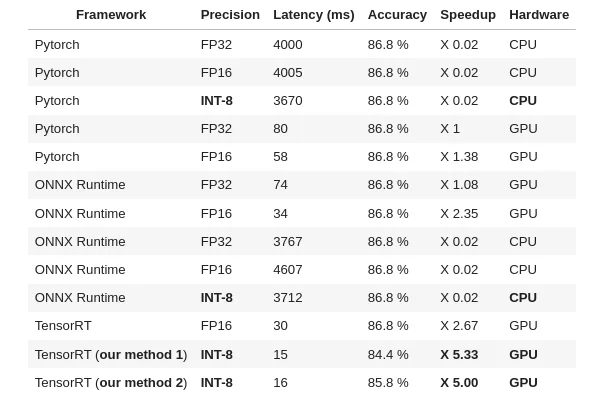1st ever method to perform GPU quantization on most 🤗 HF transformer models: > 2X faster inference!
Quantization is a technique to significantly accelerate inference by replacing high precision tensors by lower precision representation in a way where accuracy is kept intact (or close to).
It’s quite common in CPU inference, a lot less on GPU, even if the performance boost is significant.
End-to-end method (we also added many other benchmarks): https://github.com/ELS-RD/transformer-deploy/blob/main/demo/quantization/quantization_end_to_end.ipynb
The library repo (Apache 2 licence): https://github.com/ELS-RD/transformer-deploy
To give you an idea of the latency speed up:
AFAIK 3 methods of GPU quantization exist for the 2018 vanilla Bert architecture (2 from Nvidia and 1 from Microsoft) but none exist for any other architecture (Roberta, Electra, DistillBert, Deberta, etc.) limiting the benefit of GPU quantization to old models. We hope that this project will help generalisation of quantization in NLP and ease NLP big models deployment.
It’s a big deal as quantization is rarely used on GPU (unlike CPU) because it requires some Nvidia tools not well known from most ML practitioners (like TensorRT). In the lib we have wrapped those tools so they are transparent to the final user.
The result is a model that is always several times faster than vanilla Pytorch on GPU on any batch size / seq length for any transformer flavour (small, base, large, XX-large, etc.).
This work is based on a very recent model (QDQBert -> 2018 vanilla Bert which supports quantization) added by Nvidia to the Hugging Face transformer library a few weeks ago.
Next to the generic method we have developed, we have also implemented in the lib a new model as a proof of concept, QDQRoberta (and no, Roberta is not identical to Bert!). Of course the idea is to extend the process to all transformer architectures (there are not that many).
Both approaches offer different trade-offs in generalisation and accuracy (details in the notebook).
There are many things which are still to be experimented, for instance for QDQRoberta (and other future QDQ models), is Roberta source code (almost trivial) modification a good idea? Should we just patch ONNX files like Microsoft does? Or build from scratch the graph directly in TensorRT like Nvidia does? Or leverage the new Pytorch FX interface? All approaches should, in theory, lead to the same result (accuracy/speed), but offer different ease of use (final user) VS ease of maintainability (library maintainer) trade-offs.
GPU quantization is not very discussed/known in NLP, so please don’t hesitate to comment/ask questions below, so we can improve the tuto and democratize GPU quantization.
